
The juniper pug or juniper looper is a moth of the family Geometridae. The species was first described by Michael Denis and Ignaz Schiffermüller in 1775. It is found throughout the Palearctic and in the Nearctic.
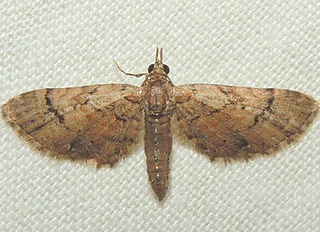
Eupithecia palpata, the small pine looper, is a moth of the family Geometridae. The species was first described by Alpheus Spring Packard in 1873. It is found in Canada and the north-eastern parts of the United States. The habitat consists of spruce woods.
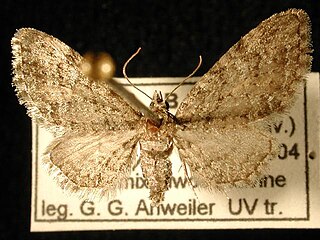
Eupithecia columbiata is a moth in the family Geometridae first described by Harrison Gray Dyar Jr. in 1904. It is found in North America from eastern Newfoundland and Labrador to Vancouver Island, south to North Carolina in the east and Colorado in the west. The habitat consists of deciduous and mixed-wood forests and forest edges, as well as shrubby areas.
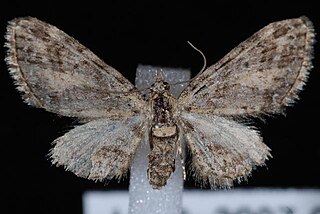
Eupithecia maestosa is a moth in the family Geometridae first described by George Duryea Hulst in 1896. It is found in North America from extreme western Alberta west to Vancouver Island, north to northern British Columbia and south to Texas and California. The habitat consists of wooded and shrubby areas.

Eupithecia borealis is a moth in the family Geometridae first described by George Duryea Hulst in 1898. It is found in North America, including Alberta, Arizona, British Columbia, California, Colorado, Manitoba, Michigan, Montana, New Brunswick, New Mexico, New York, Newfoundland and Labrador, Nova Scotia, Ontario, Quebec, Utah and Wyoming.
Eupithecia casloata is a moth in the family Geometridae first described by Harrison Gray Dyar Jr. in 1904. It is found in North America, including Yukon, British Columbia, Alberta, Saskatchewan, New Brunswick, Newfoundland and Labrador, Quebec, Washington, Montana, Oregon, Wyoming, Colorado, Utah, California, Maine and New Hampshire.

Eupithecia nimbicolor is a moth in the family Geometridae first described by George Duryea Hulst in 1896. It is found in North America from eastern Newfoundland and Labrador to western British Columbia and from Alaska to Arizona.
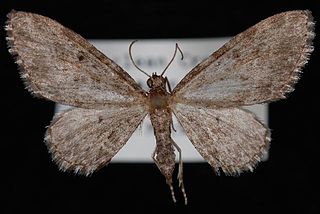
Eupithecia lachrymosa is a moth in the family Geometridae first described by George Duryea Hulst in 1900. It is found in North America from central Saskatchewan west to southern Vancouver Island, north to British Columbia and Alberta and south to California.

Eupithecia stellata is a moth in the family Geometridae first described by George Duryea Hulst in 1896. It is found in North America from central Manitoba to northern Alberta and south to California and Mexico.

Eupithecia niveifascia is a moth in the family Geometridae first described by George Duryea Hulst in 1898. It is found in North America from south-western Alberta west to Vancouver Island, north to northern coastal British Columbia and south to New Mexico.
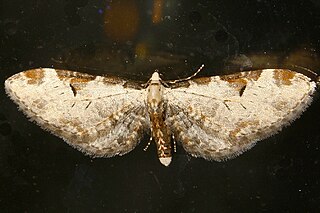
Eupithecia nevadata is a moth in the family Geometridae first described by Alpheus Spring Packard in 1871. It is found in western North America.

Eupithecia longipalpata is a moth in the family Geometridae. It is found from coastal British Columbia south to California.
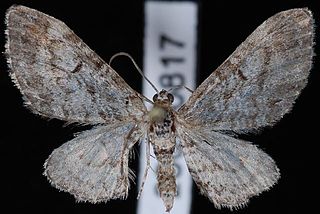
Eupithecia graefi, or Graef's pug, is a moth in the family Geometridae. The species was first described by George Duryea Hulst in 1896. It is found in North America from south-western Alberta west to Vancouver Island, north to Alaska and south to California. The habitat consists of wooded areas.

Eupithecia misturata is a moth in the family Geometridae first described by George Duryea Hulst in 1896. It is widely distributed in western North America.

Eupithecia coloradensis is a moth in the family Geometridae first described by George Duryea Hulst in 1896. It is found in North America from western Quebec and western Ontario south to North Carolina, west to New Mexico, Arizona, Colorado and south-eastern Alberta.

Eupithecia rotundopuncta is a moth in the family Geometridae first described by Alpheus Spring Packard in 1871. It is found in western North America from Arizona to the Pacific coast, north to Vancouver Island in British Columbia.

Eupithecia zygadeniata is a species of moth in the family Geometridae. It was first described by Alpheus Spring Packard in 1876 and is found in North America, with records from Texas and Montana. Adults have been recorded on wing in June and July.
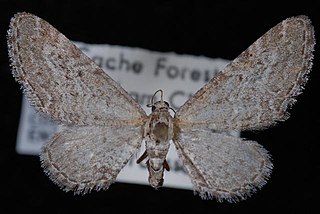
Eupithecia behrensata is a moth in the family Geometridae first described by Alpheus Spring Packard in 1876. It is found in North America from California north to British Columbia, Alberta and Saskatchewan.
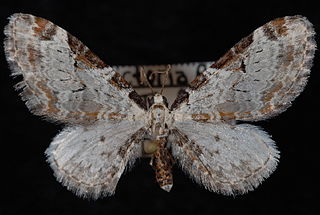
Eupithecia ravocostaliata, commonly known as the tawny eupithecia or great variegated pug, is a species of moth in the family Geometridae. The species was first described by Alpheus Spring Packard in 1876. It is found in northern New York and the New England states, extending across Canada from the Maritime provinces to Vancouver Island and down the west coast as far as the San Francisco Bay region.


















